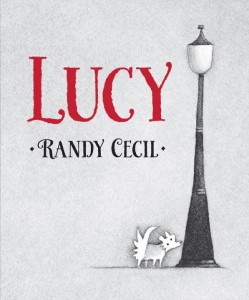2018 School Spending Survey Report
Were I on the Caldecott committee this year (I propose a rule change: please allow me to be on the committee every year), I would be eager to discuss Lucy by Randy Cecil.
 Were I on the Caldecott committee this year (I propose a rule change: please allow me to be on the committee every year), I would be eager to discuss Lucy by Randy Cecil.
Were I on the Caldecott committee this year (I propose a rule change: please allow me to be on the committee every year), I would be eager to discuss Lucy by Randy Cecil.Why is this book so discussion-worthy? So many things set it apart from other modern picture books. The duotone (which here basically means black and white) vignette illustration technique is unique. The page count (144) is unique. The structure (arranged in acts, like a play) is, yep, unique.
A quick summary, for those who haven’t read it:
Every morning fluffy pooch Lucy heads over to Eleanor’s house for a bit of sausage, which Eleanor lowers from her second-story window. Lucy is a stray, but in her dreams she remembers a past life in a loving home. Meanwhile, Eleanor’s father is a shop clerk by day and a struggling stage fright–prone juggler by night. In the end, Lucy finds a home (with Eleanor), and Eleanor’s dad finds onstage success.
We could go deep on the structure of the book, where each act (there are four in all) repeats itself before adding new information and revealing secrets. The storylines of the three characters begin to beautifully intertwine toward the end of the book. For our purposes here it’s sufficient to say that this clever setup works. The complexity of the narrative isn't hard to follow, but it does mean the book is better suited for a slightly older reader than your average picture book. Of course, this isn’t a problem in terms of Caldecott, which can include books for audiences all the way up to age 14.
Let’s talk art. The oil illustrations are mostly small vignettes (borderless circular shapes). They feel soft, intimate, and delicate. They play well with the minimal text to set a quiet mood (and, side note, there have been a whole bunch of quiet Caldecott winners). The circular shape of the illustrations is reminiscent of a spotlight — perfect for a story about a struggling performer who overcomes his fear. It's important to note that the illustrations do much of the narrative heavy lifting. For many parts of the story, it could almost work as a wordless book. This tends to impress.
The Caldecott often rewards books full of glorious full-bleed double-page spreads. That’s not the case with Lucy. Cecil’s illustrations don’t play to the back row, but rather draw the reader in. I’m trying to think of a recent Caldecott winner with similarly small illustrations, and ... is there one? So if we’re just looking at the overall history of the award, this could potentially hold Lucy back (this is not something the committee would talk about, but worth considering).
Also (and this is just speculation talk — not Caldecott criteria talk) Lucy is from an established illustrator who seems like he’s making a leap with this book. This feels like a potential “career masterpiece” sort of book. In that way it reminds me of Locomotive and Beekle, and we saw how that went for Brian Floca and Dan Santat.
So let’s review, looking at the Caldecott criteria:
“Distinguished” is defined as:
- Marked by eminence and distinction; noted for significant achievement.
- Marked by excellence in quality.
- Marked by conspicuous excellence or eminence.
- Individually distinct.
Is it a significant achievement? I’d say it scores high there. It’s a skillfully executed book that stands out.
Is it marked by excellence or quality? Yes. The beautifully intricate illustrations enhance the mood and carry much of the storytelling load.
Is it marked by conspicuous excellence? A lot hinges on this point. How passionate will committee members get about this book? I’m feeling pretty passionate.
Individually distinct? Oh yeah.
What do you say?
RELATED
RECOMMENDED
ALREADY A SUBSCRIBER? LOG IN
We are currently offering this content for free. Sign up now to activate your personal profile, where you can save articles for future viewing.








Add Comment :-
Comment Policy:
Comment should not be empty !!!
Robin Smith
I like how you stared that you would like to discuss Lucy. I notice that a lot of the winners have lots to discuss and there is a lot here, for sure. And yes, it feels like a real departure for Cecil. Thanks for making me take another look.Posted : Oct 31, 2016 12:51
rds
Randy Cecil is such a talented artist and storyteller. I've been a fan of his work for years and am so happy to see this new book that, as you say feels like a career masterpiece, getting so much love from the children's book world. It reminds me in some ways of Higgledy Piggledy Pop, one of Sendak's books that isn't as well-known as others, but that I've always adored.Posted : Oct 28, 2016 04:45
Sam Juliano
Well, I secured my own copy of it a few weeks ago, and I do LOVE it and feel it well deserves to be in the Caldecott deliberations absolutely. The vignettes are quietly captivating and yes it does make you conclude it would be just as effective in wordless terms. Wonderful appraisal and to these eyes a well deserved spotlight.Posted : Oct 27, 2016 07:00